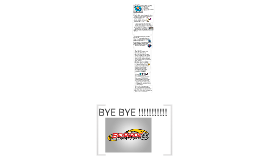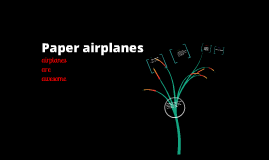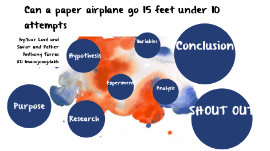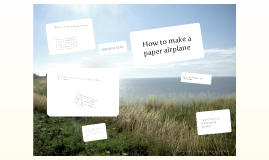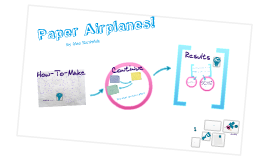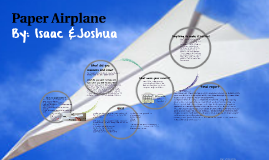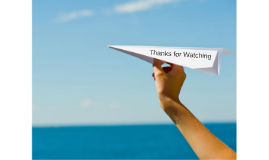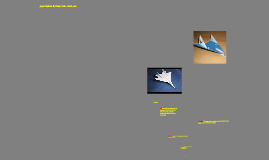Paper Airplane
Transcript: Velocity - the time rate of change of position of a body in a specified direction Time - period or interval between two successive events Distance - the extent or ammount of space between two things Speed - rapidity in moving, going, traveling,proceeding, or performing, etc. After folding both planes we marked a specific distance 3m (9ft), and timed how long it took each plane to fly that distance Image by Tom Mooring One thing that we believe would make this experiment better is to create some sort of airplane launched that will launch with the same amount of thrust every launch so that results don't vary because we humans aren't persistent with every repetition (i.e. we may give more/less thrust to the plane one one trial than we would the other but if we had a persistent launcher that wouldn't be a concern.) Thank you!!! What were your results?? Vocabulary words: Aerodynamic lift thrust gravity air drag By: Isaac &Joshua Final report *Note: P2 didn't make it the full 3m; it hit the floor before then, only traveled roughly around 1.5m till crashing* What did we learn? 1.) What would be the speed of a paper airplane that fly's a distance of 21.3 feet in 8.4 seconds *Calculate answer to m/s* 2.)Whats is the force that acts on a paper airplane in order to make it stay afloat and fly faster, and how can this be done? a) Thrust; by folding the wings up. b) Lift; by folding the wings up. c) Drag; by folding the wings down d) Gravity; by folding the wings down. Whats the physics behind it? What did you measure and how? http://allpaperplanes.weebly.com/the-physics.html What did you want to show and how were you able to show this? There are four physics components that act on a paper airplane, these are... Thrust - keeps the plane moving forward Aerodynamic lift - acting on horizontal surface areas that lifts the plane upward Gravity - which counteracts lift and pulls the plane downward Air drag - counteracts thrust and reduces the planes forward speed We wanted to show how differently folded planes have different flight abilities. we showed this through two differently folded planes (using the same material). Plane 1 was folded in a complex manner, plane 2 was folded in a simple manner as everyone may know how to fold a paper airplane. This means that Plane 1 traveled a longer distance faster than Plane 2's time for a shorter distance; Thus, plane one was faster. This also means that plane 1's more complex folds have more flight ability than the simple/quick/easy folds of plane 2. Paper Airplane How long it took to travel 3m We measured the speed of each plane by measuring the time it took to travel a specific distance. 1.8 Quiz 1.9 1.9 1 2 3 Title - Paper airplanes Goal/ Hypothesis - If we make two paper airplanes, one more complex to fold than the other, then the more complex plane will fly better than the simple one because it has a greater center of gravity and is more aerodynamic Background research - 4 physics components of a plane (lift, drag, thrust, gravity) Materials list - two sheets of paper (any), colored pencils, timer, measuring tape. Procedure - take both sheets of paper and design them however you may please (optional); make two planes using both sheets, one easy to fold, the other not so much; take your measuring tape and measure 9 ft; have a timer ready and throw each plane across the specified distance; record your results for each plane (3 trials each) Analysis- we found out that planes with greater center of gravity and larger wingspan will have more capable flying abilities Summary - Our hypothesis turned out to be correct. We would create a launcher to make results precise with each trial. we learned that the hard way is the best way, it was harder to make plane 1 than it was plane 2 and it took more time but it flew way better than plane 2 What does that mean? Anything to make it better? P1 P2 2.1 2.0 2.3 3.) What force acts against thrust? a) Air resistance b) Aerodynamics c) Drag d) Thrust 4.) If you want your paper airplane to fly at a speed of 6m/s^2 over a distance of 17.2 feet, how long would this take?






